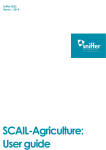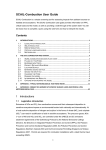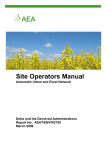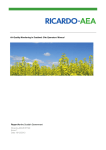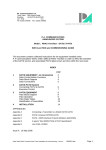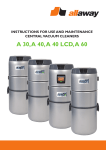Download SCAIL-Agriculture: User guide
Transcript
Sniffer ER26
April / 2014
SCAIL-Agriculture:
User guide
Contents
1.
2.
Introduction .................................................................................................................................... 3
1.1.
Legislative background........................................................................................................ 3
1.2.
Emission sources and impacts ............................................................................................ 5
1.3.
Environmental Assessment Levels, Critical Loads, Critical Levels ....................................... 6
1.4.
Meteorology........................................................................................................................ 7
The SCAIL-Agriculture Web System ................................................................................................. 8
2.1.
SCAIL-Agriculture decision flow chart ................................................................................. 8
2.2.
Filling out the Form ........................................................................................................... 10
2.3.
Interpreting the Results .................................................................................................... 21
Appendix 1:
Typical Meteorological Year Wind Roses ...................................................................... 24
Appendix 2:
Ammonia Emission Factors for Cattle ........................................................................... 46
SCAIL-Agriculture: User Guide, April 2014
2
1. Introduction
Simple Calculation of Atmospheric Impact Limits from Agricultural Sources (SCAIL-Agriculture) is a
screening tool for assessing the impact from pig and poultry farms on human health and on seminatural areas like SSSIs and SACs. The model provides an estimate of the amount of acidity and
nitrogen deposited as a consequence of ammonia emissions from a farm as well as predictions of air
concentrations of ammonia (NH3), odour and particulate matter with an aerodynamic diameter of
less than 10 microns (PM10). These values can then be used to assess whether impact limits for
human health or habitats are exceeded or not.
Please note that the updated version of SCAIL-Agriculture includes a module that provides an
estimation of PM10 concentrations. The module is currently under development in consultation with
the regulatory authorities, and should only be used to provide an indicative assessment for PM10.
The SCAIL-Agriculture user guide provides information on the Industrial Emissions Directive (IED),
critical loads and the model, as well as providing a walk-through of the system itself. You will be
shown how to complete a query using the web form and how to interpret the results.
1.1.
Legislative background
Industrial Emissions Directive - Intensive agriculture is covered under the Environmental Permitting
Regulations (in England and Wales); Pollution Prevention and Control (Scotland) Regulations 2012;
Pollution Prevention and Control (Industrial Emissions) Regulations (Northern Ireland) 2013 ('The
Regulations'); and, Environmental Protection Agency (Industrial Emissions) (Licensing) Regulations
Republic of Ireland) 2013 for the rearing of poultry and pigs. There are three main activities that are
included in the regulations, for installations with more than:
i)
ii)
iii)
40,000 places for poultry, including ducks and turkeys;
2,000 places for production pigs (over 30 kilogrammes); or
750 places for sows
For the three situations above, there is also a requirement to look at the different emission sources
of NH3 that are occurring within these types of installation - namely emissions from housing, storage
and land spreading. On an environmental permit application form, and on the SCAIL web site, you
will be asked to fill out all the sources involved in your farming operation that contribute to NH3
emissions.
Further detailed information on IED can be found on the APIS IED Directive page. The following links
will direct the user to the relevant guidance specific to the agency regulating the installation.
England:
http://www.environment-agency.gov.uk/business/sectors/40069.aspx;
Wales:
http://naturalresourceswales.gov.uk/apply-buy-report/apply-buy-grid/installations/intensivefarming/
Scotland:
http://www.sepa.org.uk/air/process_industry_regulation/pollution_prevention__control/intensive_
agriculture.aspx:
Northern Ireland:
http://www.doeni.gov.uk/niea/pollutionhome/ippc/ippc_farmregs/application_forms_and_guidance.htm;
Republic of Ireland:
http://www.epa.ie/pubs/forms/lic/ipc/#d.en.46362.
SCAIL-Agriculture: User Guide, April 2014
3
If there is the potential for deposition to have an impact on a site with a conservation designation
[e.g. Special Area of Conservation (SAC) or in the UK an Area/Site of Special Scientific Interest
(ASSI/SSSI)] then this potential impact needs to be considered.
PM10 legislation - Air quality regulation within the EU is based upon the Ambient Air Quality
Directive (2008/50/EC) and Directive 2004/107/EC, which set limits for concentrations of pollutants
in outdoor air. These are promulgated in national legislation. Air quality is a devolved matter,
though the UK government leads on international and European legislation. Administrations in
Scotland, Wales and Northern Ireland are responsible for their own air quality policy and legislation.
The Air Quality (Standards) Regulations 2010 transpose into English law the requirements of
Directives 2008/50/EC and 2004/107/EC on ambient air quality. Equivalent regulations have been
made by the devolved administrations in Scotland, Wales and Northern Ireland. The equivalent in
the Republic of Ireland is the Air Quality Standards Regulations 2011.
Odours - The Environmental Permitting Regulations require the control of pollution including odour.
In addition, action on odours can be taken under Section 80 of The Environmental Protection Act
1990 in cases where a statutory nuisance is found to exist. Whether or not odour constitutes a
statutory nuisance depends on several factors, including:
severity
duration
frequency and
whether it interferes with the "average" person's reasonable enjoyment of their property.
In other words, an unpleasant odour in someone's garden in the winter that does not enter their
house would not constitute a statutory nuisance as the "average" person would not be expected to
spend significant periods of time in their garden during cold weather. However, during warmer
weather they are more likely to be in the garden and therefore the same odour would be more likely
to constitute a statutory nuisance. A Public Inquiry at Newbiggin-on-Sea established that the 98th
percentile of hourly concentrations provided a suitable surrogate for determining an odour
nuisance. Typically concentrations above between 1 and 5 Odour Units per cubic meter of air when
evaluated as the 98th percentile of hourly values would be determined to result in odour pollution.
Horizontal Guidance from the Environment Agency for England, Wales, Scotland and Northern
Ireland and the Odour Impact Assessment Guidance for EPA Licensed Sites for the Republic of
Ireland provides further details on the assessment of odour issues for regulatory purposes.
Further, guidance can be found at:
http://www.scottishairquality.co.uk | http://www.sepa.org.uk | http://www.apis.ac.uk |
http://www.environment-agency.gov.uk |http://naturalresourceswales.gov.uk | http://www.epa.ie
| http://www.doeni.gov.uk.
SCAIL-Agriculture: User Guide, April 2014
4
1.2.
Emission sources and impacts
Ammonia (NH3), Nitrogen deposition and impacts- Ammonia (NH3) in the atmosphere results
primarily from the decomposition and volatilisation of animal wastes. As such it is in principle a
natural trace gas. However, as agricultural livestock numbers have dramatically increased, together
with increases in nitrogen fertilization, NH3 emissions have increased accordingly (Sutton et al.
19931). Emissions of ammonia lead to the deposition of nitrogen to vegetative surfaces through
processes of wet and dry deposition. Excess nitrogen deposition to terrestrial plants can lead to
eutrophication effects, and communities most at risk are those rich in mosses and lichens, and
where species richness is comprised of slow growing species. Competition from invasive species,
often grasses, poses a threat for many plant communities but the type of species invading will
depend on the proximity of a seed source (arable, farmed land). Nitrogen deposition can also
increase the risk of damage from drought (summer and winter) and frost.
PM10 - Particulate pollution is composed of particles that are small enough to remain suspended in
the air. Particulate matter pollution consists of very small particles floating in the air, which can
include smoke, soot, dust, salts, acids, metals, and semi-volatile liquids. Particulate matter also
forms when gases emitted from industrial and combustion sources, and motor vehicles undergo
chemical reactions in the atmosphere. Particulate pollution also can include materials that can be
highly toxic. Exposure to such particles can affect both the lungs and heart.
PM10 refers to particulate matter less than 10 microns in diameter, about one seventh the thickness
of a human hair. Major sources of PM10 include motor vehicles; wood burning stoves and fireplaces;
dust from construction, landfills, and agriculture; wildfires and brush/waste burning, industrial
sources, windblown dust from open lands; and atmospheric chemical and photochemical reactions.
Suspended particulates produce haze and reduce visibility.
Odour - Odour is the smell that we are able to detect from substances, carried by air into our
nostrils. The ability of odours to be carried long distances in the air means that odours have the
ability to affect a large number of people. The degree to which people are affected will however
depend on the sensitivity of their sense of smell and their tolerance of the odour in question. Odour
problems are typically associated with the following:
fumes from boilers, etc.
smoke from bonfires or chimneys
accumulations of waste (e.g. dog faeces, food items, etc.)
odour arising from the manner in which animals are kept and
odour from industrial, trade or business premises
Occasionally, pollutants have an accompanying odour, e.g. hydrogen sulphide or ammonia.
1
Sutton M. A., Pitcairn C. E. R. and Fowler D. (1993) The exchange of ammonia between the atmosphere and
plant communities. Advances in Ecological Research 24, 301-392.
SCAIL-Agriculture: User Guide, April 2014
5
1.3.
Environmental Assessment Levels, Critical Loads, Critical Levels
For many substances which are released to air Environmental Quality Standards have not been
defined. Where the necessary criteria are absent then the Regulators have adopted interim values
known as Environmental Assessment Levels (EALs). The EAL is the concentration of a substance
which in a particular environmental medium the Regulators regard as a comparator value to enable
a comparison to be made between the environmental effects of different substances in that medium
and between environmental effects in different media and to enable the summation of those
effects.
PM10 are governed by ambient air quality standards set out in the Air Quality (Standards) Regulations
2010. In England, Wales, and Ireland for PM10, the daily average concentration limit is 50 µg/m3, not
to be exceeded more than 35 times a calendar year. For Scotland the PM10 daily average
concentration limit is 50 µg/m3, not to be exceeded more than 7 times a calendar year.
Critical Loads/levels are the threshold level for the deposition or concentration of a pollutant above
which harmful indirect effects can be shown on a habitat or species, according to current
knowledge. Additional deposition above the Critical Load/Level is termed Critical Load/Level
Exceedance. For agricultural practices we are primarily interested in the critical loads for nitrogen
and acidity and the critical level for ammonia (NH3) since emissions from livestock farming lead to
increased pollutant loads which could cause harmful effects. The impact of excess nitrogen
deposition is always quoted in Kg of nitrogen per hectare per year (Kg N/ha/yr) whilst acid
deposition is quoted in Kg of hydrogen ion equivalents (K Eq H+) per hectare per year (K Eq H+/ha
/yr). Further information on critical loads can be found at:
www.apis.ac.uk/overview/issues/overview_Cloadslevels.htm.
Critical levels for ammonia are quoted in µg/m3 and have been set for lichens/bryophytes and other
vegetation.
SCAIL-Agriculture: User Guide, April 2014
6
1.4.
Meteorology
The SCAIL-Agriculture screening model uses an approach that uses data from nearby meteorological
stations. The Typical Meteorological Year approach is used to derive meteorological data to best
represent the long-term dataset based on the similarity of the annual wind direction distribution to
the long-term average (five year). Similarity of long-term wind direction distributions of nearby
stations has been used to reduce the number of meteorological stations used. The 30 stations
included in the model for the UK are shown in Figure 1a, and the 11 stations for the Republic of
Ireland are shown in Figure 1b.
Figure 1 Meteorological Station used in SCAIL-Agriculture
a: 30 Meteorological Station used in SCAIL-Agriculture for the UK
b: 11 Meteorological Station used in SCAIL-Agriculture for the Republic of Ireland
SCAIL-Agriculture: User Guide, April 2014
7
2. The SCAIL-Agriculture Web System
This section provides a brief walk-through of the system and will guide you through the form filling
exercise and interpretation of the results.
2.1.
SCAIL-Agriculture decision flow chart
Error! Reference source not found. shows the flow diagram of the SCAIL agriculture tool and the
decisions that may be taken in carrying out an environmental assessment. Since the tool compares a
number of metrics for habitats or human health, obtaining no exceedance on all limits may be
difficult. Where environmental standards are already exceeded by the background or the new
installation results in an exceedance you should consult the relevant regulatory guidance for further
action.
In addition, for emissions of ammonia where a sensitive receptor is located within 250 metres of the
installation the following guidance must be followed:
For intensive farming sites that are regulated under the Environmental Permitting
Regulations (EPR) in England and Wales (PPC permitted sites in Scotland, IPPC in Northern
Ireland) and with distances to the nearest sensitive receptor of less than 250m, applicants
must go straight to undertaking detailed modelling.
For non-EPR (PPC / IPPC) sites with distances to the nearest sensitive receptor between 100250m, SCAIL can be used and then advice must be sought from the regulator for clarification
on whether detailed modelling is required.
For sites with distances to the nearest sensitive receptor of less than 100m, detailed
modelling will be required.
SCAIL-Agriculture: User Guide, April 2014
8
Figure 2: SCAIL Agriculture flow chart
SCAIL-Agriculture: User Guide, April 2014
9
2.2.
Filling out the Form
Throughout the SCAIL-Agriculture web system the user is provided with guidance notes by using the
information icon ( ). By clicking the mouse on the icon (see Figure 3) text is displayed in the grey
box on the right of the form giving guidance on the relevant input field.
Figure 3: How to use the guidance info tool
Entering Input Data:
All the information needed to run the model is entered on the web form. However, if you have
saved input data from a previous run, this can be loaded by clicking on the Load Input Data button
at the top-right of the form. This will bring up a window where the input file can be selected and
loaded (Figure 4). This will populate the form with the saved input data, ready to edit or run.
Figure 4: Specifying file for loading input data
Project Details & Run Mode:
In the Project Notes box you can enter details on the sources to be modelled and the type of run
being carried out, e.g. ‘worst case’ or ‘realistic’. This information is copied onto the output screen
and also to any output files saved (Figure 5).
For the Project Run Mode, either Conservative or Realistic Met can be chosen (Figure 5).
Where SCAIL-Agriculture results are to be reported to the relevant regulatory authority, results
must be produced using the Conservative Met run mode.
SCAIL-Agriculture: User Guide, April 2014
10
SCAIL-Agriculture can be used in either mode as a guide for non-regulatory purposes such as
exploratory investigations for planning, pre-application or research.
Realistic Met will use the actual position of the habitat site, and Conservative Met will rotate the
habitat site so that it is in the prevailing wind direction for the meteorological file being used and
hence receive the highest amount of pollutant concentration and deposition. The ‘Conservative Met’
assumption can help to ensure that the effects of local wind fields are captured. However, the
method works best for situations where there are either single sources or sources are closely
grouped, and care needs to be taken with sources that are widely spaced apart. For this reason, the
use of SCAIL-Agriculture is not suitable for regulatory screening of sites with multiple installations
or dispersed sources, and the relevant Regulatory Authority should be contacted for advice.
Where SCAIL-Agriculture is not being used for regulatory purposes, in situations where a large
number of sources are being modelled across a wide geographical area, the modeller should use the
actual source position as applied through the “realistic met” option.
Details of the meteorological sites included in SCAIL-Agriculture can be seen in Appendix 1. The
prevailing wind direction at each of the meteorological sites is listed in Table A1.1, ‘Wind Direction
(degrees)’.
The following examples illustrate the use of the ‘Conservative Met’ option. The left hand and centre
figures illustrate that the rotation of the receptor locations into the prevailing wind direction works
well when sources are located close to Installation number 1. The source midpoint is determined by
the location of Installation number 1 as defined by the user. The methodology does not work well
when sources are distant from Installation number 1 as shown in the right hand figure.
SCAIL-Agriculture: User Guide, April 2014
11
Location Details:
For each site query you will need to choose a UK country or the Republic of Ireland (Figure 5).
Figure 5: Initial project setup
Installation Details:
An Installation is the facility or group of Sources for which the assessment of releases is required.
More than one Installation can be specified if the assessment is for a number of releases from
different locations or if you want to see detailed output from a particular Source in isolation from
the other Sources being modelling (such as for a Source apportionment study). The use of SCAILAgriculture is not suitable for regulatory screening of sites with multiple installations or dispersed
sources. In these cases, the relevant Regulatory Authority must be contacted for advice. Click on
the down arrow next to the Installation to add another Installation, otherwise select the Installation
identifier for which you are about to enter details (the default is 1 for the first Installation). If other
Installations have been added, more than 1 identifier will be present (Figure 6). To delete an
Installation, select the Installation then click on the cross next to the Installation selection box.
Figure 6: Specifying an installation
Enter the Installation name, and then add the location details. Put in the grid reference of the
location of the habitat at its nearest edge to your source. You can enter either Landranger (e.g.
NJ692258) or OS x,y co-ordinates (e.g. 369250,825850) in metres. For Northern Ireland and the
Republic of Ireland, only x,y co-ordinates (e.g. 145665,156755) in metres can be used.
Confirm that the location of the Installation is correct by clicking on ”Verify Location”. This opens a
Google Maps window showing the co-ordinate locations entered (Figure 7). The map can be
zoomed to confirm the exact installation location. If not, the location can be moved by clicking at
the appropriate location on the Map, then clicking on OK to confirm the new location. The new
location co-ordinates are transferred back to the Installation Location box. Close the Map box when
finished.
SCAIL-Agriculture: User Guide, April 2014
12
Figure 7: Verifying the location details
Source Details:
Each Installation is made up of a number of discrete Sources representing component contributions
on the farm from which pollutants are emitted. It should be noted that SCAIL-Agriculture groups all
the contributing sources in an Installation and therefore you will not be able to tell how much
contribution to the total concentration or deposition a particular Source made (i.e. to identify which
of a number of animal houses made the highest contribution or whether stored manure or housed
animals were likely to be the cause of an odour problem). Where you require details of the specific
contributions then simply create a separate Installation and put the source you want to specifically
identify into this Installation (Installations can overlap each other).
Sources can be buildings housing animals, for instance, or manure heaps/stores or land spreading.
The Source details section allows the specification of each Source at an Installation. Enter the details
for each Source. If you want to use multiple Sources, fill in the details for one Source, then select
Add Source from the Source drop-down and fill in the details for the additional Source. Sources can
be removed using the red delete button (Figure 7). Up to 20 sources can be added.
For each Source, enter a Source name and a location. This process is identical to the specification of
Installation location. Enter the relevant co-ordinates, then click on Verify location to open the map
window allowing the source location to be confirmed or moved by clicking at a new location and
clicking “OK” to confirm the new location (Figure 7).
Select whether the Source is related to pigs or poultry by clicking the appropriate Radio button, and
confirm whether a Source is new or existing. If your application is for a new Installation or Source,
select 'New'. If you are including an existing Source , select 'Existing'. Nitrogen deposition from
existing Sources are already included in the background totals and should therefore be removed to
avoid double counting of Sources. SCAIL carries this process out for you (Figure 8).
SCAIL-Agriculture: User Guide, April 2014
13
Figure 8: Specifying Source details
Select Pig or Poultry depending on the livestock type you are assessing. At this point you are now
ready to enter the data that will be used to calculate the emissions coming from the various
agricultural Sources. SCAIL uses the same emission factors found in the IPPC application. There are
three menus associated with Source type (Figure 8). Most of the time you will need to select all 3.
The first select list shows the three main types of agricultural Sources:
1. Housing
2. Litter / Manure Storage
3. Land Spreading
The second select menu will depend on what is selected in the first menu, but it will contain
livestock types, storage or land spreading operations. Finally the third select menu gives further
detail. The two input boxes are for inputting the number of livestock or area of housing or volume of
slurry spread on fields. For example, in Figure 8 the user has selected "Housing", "Layers" and
"Ventilated deep pit". There are 10000 layers in the housing unit which has an area of 1000 m2 (50 x
SCAIL-Agriculture: User Guide, April 2014
14
20 m shed). It should be noted that SCAIL-Agriculture includes buildings as cuboids, hence this
building will be represented in the tool as having a footprint of 31.6 m x 31.6 m.
If housing is selected, you are prompted to specify the building height and select if the building is
naturally ventilated. If the building is not naturally ventilated (i.e. it is ventilated by mechanical fans)
then specify the location of the ventilation fans as either “Roof” or “Side of Building” using the “Fan
Location” drop down. If you do not know the location of the ventilation fans or if there is a roughly
even split between fans mounted on the roof and walls of the building then you should select “Side
of Building”. When “Roof” mounted fans are selected then you should specify the number of fans,
the diameter of a typical exhaust and airflow of a typical fan (Figure 9). If any of information
required for including “Roof” mounted fans is unknown then use the “Side of Building” option.
Guidelines on the ventilation rates for typical livestock types can be found in Table 2-D of the SCAILAgriculture report.
Figure 9: Specifying options for housing
Finally specify the Livestock number and the footprint area of the animal housing and the type of
animal housed in the building (see Figure 10 for types available). As a guide, the animal welfare
regulations (The Welfare of Farmed Animals (England) Regulations 2007) recommends minimum
floor areas that must be provided for livestock.
Figure 10: Specifying animal types for housing
The last input stage is to specify the housing regime for the animal (Figure 11), then click on the “Get
Emission Values” button to populate the values from the database defaults according to the options
selected and input values. User-specified values can be added and comments on the Source
entered. Where any manual modification is made to the emission rates then suitable comments
should be included to provide a record of any assumptions made.
SCAIL-Agriculture: User Guide, April 2014
15
Figure 11: Specify housing regime
For manure storage, enter the mass of manure and area of storage, then select the storage type
(Figure 12). Now click on the “Get Emission Values” button and the emissions of ammonia, PM10 and
odour will be populated with values from the database defaults according to the options selected
and input values. These values can be replaced by user-defined values if required, and a comment
added about the values used.
Figure 12: Specifying Litter/Manure storage parameters
Similarly, if land spreading is selected, enter the mass of manure to be spread, and the area over
which it is spread and the number of applications per year. Select the type of application (Figure
13), the type of poultry where relevant (Figure 14), then Press the “Get Emission Values” button and
the emissions of ammonia, PM10 and odour will be populated with values from the database
according to selections made. Again, user-specified values can be added and comments on the
Source entered.
Figure 13: Specifying Land spreading parameters
Figure 14: Specifying poultry type for land spreading selection
Complete the entry of all details for all Sources required
TIP for modelling types of Sources not included in the tool
SCAIL-Agriculture provides a flexible platform for modelling a multitude of Sources. The
inclusion of Pig and Poultry within the tool relates to the automated look-up of emissions
data although the users of the tool are able to overwrite these values with their own
emission calculations (suitable commentary should be added). Ammonia emission factors for
dairy cattle are provided at the end of this user guide (Appendix 2) and could be applied to
model dairy housing (it is recommended that the naturally ventilated housing option is
applied). Likewise modelling of emissions from on-farm anaerobic digestion units could
apply the point source modelling approximations to treat a range of types of emissions.
SCAIL-Agriculture: User Guide, April 2014
16
Entering designated site details:
Enter the radius over which you would like an automated search of designated sites, then click on
the “Run receptor search” button. It should be noted that this search will be centred on the location
that was specified for Installation number 1. This searches on-line databases for designated sites
within the specified radius from the Installation and produces a list of all sensitive designated sites
found (Figure 15). This list shows the site name, the distance to the Installation and the site
designation.
Figure 15: Receptor details within a specified distance of an Installation
Clicking on the Verify Receptor Locations button produces a map showing the Installation and
identified receptor locations (Figure 16). Further information on the specific habits is provided by
hovering the mouse over the blue “Receptors” pins; these show the closest edge of the identified
habitats. The red “Receptor” pin shows the location of the first Installation that was added.
Figure 16: Confirming Receptor locations in relation to an Installation
SCAIL-Agriculture: User Guide, April 2014
17
There is also the facility to add User-specified sites. This can be used where new sites may have
arisen, for example, or where other semi-natural areas need assessing. Click on Add site, then enter
a name and location for the site. You should also select the habitat type within the Receptor site
(Figure 17).
Figure 17: Specifying habitat type for a user defined receptor
Confirm the site location using the map, then at this stage you can use the Check Background Levels
button to check the background concentration and deposition levels for each pollutant at the habitat
grid reference entered and then compare these levels with the Critical Load/Level of the selected
Habitat Type (Figure 18). This information will open in a new window. More User-specified sites can
be added in the same way and individual sites can be deleted by selecting the site, then pressing the
red delete button next to the Add site button.
Figure 18: Background levels at User-specified habitat sites.
Entering Human Receptor details:
There is also the facility to add User-specified Human Receptor sites. These are used to assess
concentrations of PM10 and odour. There are a number of statistics that are relevant for PM10
exposure hence SCAIL Agriculture allows the user to specify either the 90th percentile, 98th percentile
or annual average statistic, these are selected using the “PM10 percentile” drop-down shown in
Figure 19.
SCAIL-Agriculture: User Guide, April 2014
18
The method is very similar to the addition of user-specified habitat sites as described in the previous
section. Click on Add receptor, then enter a name and location for the Receptor. Confirm the site
location using the map, then at this stage you can use the Check Background PM10 Levels button to
check the background PM10 concentration at the location read from APIS (Figure 19). As before,
more Human Receptor sites can be added in the same way and individual receptors can be deleted
by selecting the receptor, then pressing the red delete button next to the Add receptor button. It
should be noted that background concentrations for odour are not required in the assessment.
Figure 19: Checking PM10 background at specified receptors and selecting the output statistic for
PM10 assessments.
Saving the input file:
Use the Save input data button to save all the information entered on the form for this project
(Figure 20 and Figure 21). This will enable the same scenario to be run again or modified without
having to enter all the information again. A user-specified file can be saved (Figure 20) although this
depends on the internet browser that you are using (the options shown in Figure 20 are relevant to
Microsoft Internet Explorer). This file should be renamed if you want to save multiple runs in the
same folder. If you forget to save the input data at this stage, it can be saved from the results page
after the model has run.
Figure 20: Specifying file name for saving input data (options depend on the browser that you are
using).
Clearing the Form:
If you want to clear the form, deleting all the Sources that have been set up, click on the Clear Form
button (Figure 21). If the input data is required later, make sure you have saved the data first using
the Save Input Data button.
SCAIL-Agriculture: User Guide, April 2014
19
Running the model:
Before running the assessment tool you can add any additional information about the Assessment in
the notes box. Save the input file if you wish to re-use the input data. Once you are happy that all
the information has been correctly entered on the form, click the Calculate button to run the
assessment (Figure 21).
Figure 21: Buttons to run the model, save the input data or clear the form
A holding screen is displayed while the calculations are being undertaken (Figure 22).
Figure 22: Holding screen while calculation is on-going
SCAIL-Agriculture: User Guide, April 2014
20
2.3.
Interpreting the Results
Once the assessment has run, you will be presented with the results page. To display the results for
different receptor site click the box in top left of the Results form (Figure 23). Help text can be
accessed by clicking on the information icon ( ). This text appears in the “Content Specific Help
Text” box at the top of the screen as shown in Figure 23.
The output screen is split into:
Site Information – information on the selected site (name, location, distance from Installation
No. 1 etc.) as well as generic information on the model run (met. site, run mode and the PM10
percentile that was applied).
Installation Information – emissions, concentrations and deposition values subdivided by
each Installation included in the assessment. This includes information on the total number
of Sources included in each Installation and the number of Sources that were flagged as
being “New” Sources.
Total Deposition/ Concentrations and Exceedences – concentrations and deposition values
totalled for all Installations included in the assessment. These can include information on the
relevant Environmental Assessment Level or Critical Load/Level based on the pollutant and
receptor type being modelled.
Figure 23: Selecting different receptor sites to display
Results are displayed for PM10, NH3, Odour, Nitrogen deposition and acid deposition (Figure 24). A
breakdown of the total concentration and deposition to the habitat is given together with the
background concentration/deposition, based on the grid reference supplied for the habitat. An
exceedance (total value – environmental standard) is then calculated and displayed as both a
percentage and an absolute value. A positive value indicates an exceedance and is shown in red.
The relevant regulatory authority should be contacted for advice regarding as to whether further
detailed modelling will be required if one or more of the following threshold levels are met or
exceeded (based on results produced using the Conservative Met run mode):
PM10 - greater than the threshold level of 10% of the relevant standard / critical level
NH3 – greater than the threshold level of 1% of the relevant standard / critical level
Odour – greater than the threshold level of 10% of the relevant standard / critical level
For more information on how to interpret the results please consult the relevant regulatory
Guidance Document for the country that the assessment is being conducted.
SCAIL-Agriculture: User Guide, April 2014
21
Figure 24: Results screen (Displayed Critical Load values are examples only)
SCAIL-Agriculture: User Guide, April 2014
22
Options after running the model:
At the bottom of the results page are several options (Figure 24). The Save Results button will save
the output data in CSV (comma separated variables) format, which can be opened in Microsoft
Excel.
The Save Inputs button can be used to save the input data for this model run if it was not saved on
the input form before running the model.
You can return to the Input Page by clicking on the Back Page button at the bottom of the page.
If you use your browser’s Back button to go back to the input page, you may lose the input data
you filled out on the form.
SCAIL-Agriculture: User Guide, April 2014
23
Appendix 1: Typical Meteorological Year Wind Roses
Table A1.1: Details of meteorological sites included in SCAIL-Agriculture
Station X Station Y
Name
Station
Station
Coordinate Coordinate
(Short)
Grid
(m)
(m)
AVIEMORE
AVIE
OS
289652
814315
BALLYKELLY
BALL
IRL
263400
423800
BOULMER
BOUL
OS
425300
614200
CARDIFF WEATHER
CARD
OS
318200
176100
CENTRE
CHURCH FENTON
CHUR
OS
452818
438027
COLESHILL
COLE
OS
421090
286940
CROSBY
CROS
OS
329940
400570
EDINBURGH GOGARBANK EDIN
OS
316100
671400
ESKDALEMUIR
ESKD
OS
323500
602600
GLASGOW BISHOPTON
GLAS
OS
241788
671073
HEATHROW
HEAT
OS
507700
176700
ISLAY PORT ELLEN
ISLA
OS
132900
651300
ISLE OF PORTLAND
ISLE
OS
367798
69251
LERWICK
LERW
OS
445392
1139664
LEUCHARS
LEUC
OS
346800
720900
LOSSIEMOUTH
LOSS
OS
321249
869822
LYNEHAM
LYNE
OS
400629
178255
MARHAM
MARH
OS
573700
309100
MUMBLES HEAD
MUMB
OS
262700
187000
PLYMOUTH
PLYM
OS
249219
52714
MOUNTBATTEN
PORTGLENONE
PORT
IRL
299100
403100
SENNYBRIDGE NO 2
SENN
OS
289408
241777
SKYE LUSA
SKYE
OS
170593
824888
SPADEADAM NO 2
SPAD
OS
364700
573000
STORNOWAY AIRPORT
STOR
OS
146443
933104
VALLEY
VALL
OS
230885
375849
DYCE
DYCE
OS
387810
812800
PRESTWICK RNAS
PRES
OS
236902
627653
TIREE
TIRE
OS
99900
744600
WICK AIRPORT
WICK
OS
336490
952230
BELLMULLET
BIRR
CASEMENT
CORK
DUBLIN AIRPORT
KILLKENNY
KNOCK
MULLINGAR
ROSSLARE
SHANNON
VALENTIA
BELL
BIRR
CASE
CORK
DUBL
KILK
KNOC
MULL
ROSS
SHAN
VALE
SCAIL-Agriculture: User Guide, April 2014
IRL
IRL
IRL
IRL
IRL
IRL
IRL
IRL
IRL
IRL
IRL
70220
206158
303878
166139
316878
250828
139548
243023
309980
138530
45204
335187
205628
229925
65739
243079
155810
282924
253295
114606
162095
77945
Station
Elevation
(m)
228
4
23
Wind
Direction
(degrees)
210
110
250
52
230
8
96
9
57
242
59
25
17
52
82
10
6
145
21
32
270
200
150
250
190
210
210
140
250
170
260
250
210
210
270
50
90
64
307
18
285
15
10
62
10
10
30
330
230
210
250
190
210
170
250
190
150
11
73
94
154
71
66
205
104
26
6
25
190
190
220
220
250
180
210
220
220
250
170
24
Aviemore
Ballykelly
340°
0°
350°
10°
500
330°
320°
340°
20°
320°
40°
400
310°
50°
60°
200
290°
280°
80°
100
270°
90°
260°
100°
250°
110°
120°
230°
130°
220°
140°
210°
150°
200°
0
190°
3
180°
6
10
170°
16
160°
(knots)
30°
40°
1200
50°
900
300°
70°
240°
60°
600
290°
280°
70°
80°
300
270°
90°
260°
100°
250°
110°
240°
120°
230°
130°
220°
140°
210°
150°
200°
190°
180°
170°
1.5
3.1
5.1
Figure A1.1. Aviemore Wind rose for 2001
SCAIL-Agriculture: User Guide, April 2014
8.2
(m/s)
160°
0
3
6
10
16
(knots)
0
1.5
3.1
5.1
8.2
(m/s)
Wind speed
0
20°
310°
300
300°
10°
1500
330°
30°
0°
350°
Wind speed
Figure A1.2. Ballykelly Wind rose for 2001
25
Boulmer
340°
0°
350°
Cardiff Weather Centre
10°
800
330°
20°
340°
30°
320°
40°
310°
300°
320°
50°
60°
290°
200
80°
270°
90°
260°
100°
250°
110°
120°
230°
130°
220°
140°
210°
150°
200°
0
190°
3
180°
6
10
170°
16
30°
40°
800
50°
600
300°
70°
240°
60°
400
290°
280°
70°
80°
200
270°
90°
260°
100°
250°
110°
240°
120°
230°
130°
220°
140°
210°
160°
150°
200°
(knots)
0
190°
3
180°
6
10
170°
16
Wind speed
0
1.5
3.1
Figure A1.3. Boulmer Wind rose for 2004
SCAIL-Agriculture: User Guide, April 2014
5.1
8.2
20°
310°
400
280°
10°
1000
330°
600
0°
350°
160°
(knots)
Wind speed
(m/s)
0
1.5
3.1
5.1
8.2
(m/s)
Figure A1.4. Cardiff Weather Centre Wind rose for 2003
26
Coleshill
Church Fenton
340°
0°
350°
10°
500
330°
320°
340°
20°
320°
40°
310°
280°
70°
80°
100
270°
90°
260°
100°
250°
110°
240°
120°
230°
130°
220°
140°
210°
150°
200°
0
190°
3
180°
6
10
170°
16
30°
40°
400
50°
300
300°
60°
200
290°
60°
200
290°
280°
70°
80°
100
270°
90°
260°
100°
250°
110°
240°
120°
230°
130°
220°
140°
210°
150°
200°
160°
0
(knots)
190°
3
180°
6
10
170°
16
1.5
3.1
5.1
Figure A1.5. Church Fenton Wind rose 2003
SCAIL-Agriculture: User Guide, April 2014
8.2
160°
(knots)
Wind speed
Wind speed
0
20°
310°
50°
300
300°
10°
500
330°
30°
400
0°
350°
0
(m/s)
1.5
3.1
5.1
Figure A1.6. Coleshill Wind rose for 2001
27
8.2
(m/s)
Edinburgh Gogarbank
Crosby
340°
0°
350°
10°
600
330°
320°
340°
20°
310°
70°
200
280°
80°
100
270°
90°
260°
100°
250°
110°
240°
120°
230°
130°
220°
140°
210°
150°
200°
0
190°
3
180°
6
10
170°
16
30°
40°
800
50°
600
300°
60°
300
290°
60°
400
290°
280°
70°
80°
200
270°
90°
260°
100°
250°
110°
240°
120°
230°
130°
220°
140°
210°
150°
200°
160°
0
(knots)
190°
3
180°
6
10
170°
16
1.5
3.1
5.1
Figure A1.7. Crosby Wind rose for 2001
SCAIL-Agriculture: User Guide, April 2014
8.2
160°
(knots)
Wind speed
Wind speed
0
20°
310°
50°
400
300°
320°
40°
500
10°
1000
330°
30°
0°
350°
0
(m/s)
1.5
3.1
5.1
8.2
(m/s)
Figure A1.8. Edinburgh Gogarbank Wind rose for 2003
28
Glasgow Bishopton
Eskdalemuir
340°
0°
350°
10°
800
330°
340°
20°
320°
40°
600
310°
300°
290°
70°
200
280°
80°
270°
90°
260°
100°
250°
110°
240°
120°
230°
130°
220°
140°
210°
150°
200°
0
190°
3
180°
6
170°
10
16
30°
40°
50°
400
300°
60°
400
60°
300
290°
70°
200
280°
80°
100
270°
90°
260°
100°
250°
110°
240°
120°
230°
130°
220°
140°
210°
150°
200°
160°
0
(knots)
190°
3
180°
6
10
170°
16
1.5
3.1
5.1
Figure A1.9. Eskdalemuir Wind rose for 2004
SCAIL-Agriculture: User Guide, April 2014
8.2
160°
(knots)
Wind speed
Wind speed
0
20°
500
310°
50°
10°
600
330°
30°
320°
0°
350°
0
(m/s)
1.5
3.1
5.1
8.2
(m/s)
Figure A1.10. Glasgow Bishopton Wind rose for 2001.
29
Islay Port Ellen
Heathrow
340°
0°
350°
10°
600
330°
320°
340°
20°
310°
70°
200
280°
80°
100
270°
90°
260°
100°
250°
110°
240°
120°
230°
130°
220°
140°
210°
150°
200°
0
190°
3
180°
6
10
170°
16
30°
40°
400
50°
300
300°
60°
300
290°
60°
200
290°
280°
70°
80°
100
270°
90°
260°
100°
250°
110°
240°
120°
230°
130°
220°
140°
210°
150°
200°
160°
0
(knots)
190°
3
180°
6
10
170°
16
1.5
3.1
5.1
Figure A1.11. Heathrow Wind rose for 2001
SCAIL-Agriculture: User Guide, April 2014
8.2
160°
(knots)
Wind speed
Wind speed
0
20°
310°
50°
400
300°
320°
40°
10°
500
330°
30°
500
0°
350°
0
(m/s)
1.5
3.1
5.1
8.2
Figure A1.12. Islay Port Ellen wind rose for 2005
30
(m/s)
Isle of Portland
340°
0°
350°
10°
600
330°
320°
Lerwick
20°
340°
30°
310°
300°
320°
50°
400
60°
80°
100
270°
90°
260°
100°
250°
110°
240°
120°
230°
130°
220°
140°
210°
150°
200°
0
190°
3
180°
6
10
170°
16
30°
40°
400
50°
300
300°
70°
200
280°
60°
200
290°
280°
70°
80°
100
270°
90°
260°
100°
250°
110°
240°
120°
230°
130°
220°
140°
210°
160°
150°
200°
(knots)
0
190°
3
180°
6
10
170°
16
Wind speed
0
1.5
3.1
5.1
8.2
Figure A1.13. Isle of Portland wind rose for 2001
SCAIL-Agriculture: User Guide, April 2014
20°
310°
300
290°
10°
500
330°
40°
500
0°
350°
160°
(knots)
Wind speed
(m/s)
0
1.5
3.1
5.1
Figure A1.14. Lerwick wind rose for 2005
31
8.2
(m/s)
Leuchars
340°
0°
350°
Lossiemouth
10°
1000
330°
320°
20°
340°
30°
310°
50°
280°
60°
80°
200
270°
90°
260°
100°
250°
110°
120°
230°
130°
220°
140°
210°
150°
200°
0
190°
3
180°
6
10
170°
16
40°
300°
70°
240°
30°
600
310°
400
290°
50°
60°
400
290°
70°
200
280°
80°
270°
90°
260°
100°
250°
110°
240°
120°
230°
130°
220°
140°
210°
160°
150°
200°
(knots)
0
190°
3
180°
6
10
170°
16
Wind speed
0
1.5
3.1
5.1
Figure A1.15. Leuchars wind rose 2003
SCAIL-Agriculture: User Guide, April 2014
8.2
20°
320°
600
300°
10°
800
330°
40°
800
0°
350°
160°
(knots)
Wind speed
(m/s)
0
1.5
3.1
5.1
Figure A1.16. Lossiemouth wind rose 2004
32
8.2
(m/s)
Lyneham
340°
0°
350°
Marham
10°
600
330°
320°
20°
340°
30°
310°
300°
320°
50°
400
60°
80°
100
270°
90°
260°
100°
250°
110°
240°
120°
230°
130°
220°
140°
210°
150°
200°
0
190°
3
180°
6
10
170°
16
30°
40°
400
50°
300
300°
70°
200
280°
60°
200
290°
280°
70°
80°
100
270°
90°
260°
100°
250°
110°
240°
120°
230°
130°
220°
140°
210°
160°
150°
200°
(knots)
0
190°
3
180°
6
10
170°
16
Wind speed
0
1.5
3.1
5.1
Figure A1.17. Lyneham wind rose for 2002
SCAIL-Agriculture: User Guide, April 2014
8.2
20°
310°
300
290°
10°
500
330°
40°
500
0°
350°
160°
(knots)
Wind speed
(m/s)
0
1.5
3.1
5.1
Figure A1.18. Marham wind rose for 2001
33
8.2
(m/s)
Plymouth Mountbatten
Mumbles Head
340°
0°
350°
10°
800
330°
340°
20°
320°
40°
600
310°
300°
290°
70°
200
80°
270°
90°
260°
100°
250°
110°
120°
230°
130°
220°
140°
210°
150°
200°
0
190°
3
180°
6
10
170°
16
30°
40°
400
50°
300
300°
60°
240°
60°
200
290°
280°
70°
80°
100
270°
90°
260°
100°
250°
110°
240°
120°
230°
130°
220°
140°
210°
150°
200°
160°
0
(knots)
190°
3
180°
6
10
170°
16
1.5
3.1
5.1
8.2
Figure A1.19. Mumbles Head wind rose for 2001
SCAIL-Agriculture: User Guide, April 2014
160°
(knots)
Wind speed
Wind speed
0
20°
310°
50°
400
280°
10°
500
330°
30°
320°
0°
350°
0
(m/s)
1.5
3.1
5.1
8.2
(m/s)
Figure A1. 20. Plymouth Mountbatten wind rose for 2001
34
Portglenone
340°
0°
350°
10°
800
330°
Sennybridge
20°
340°
30°
320°
40°
300°
50°
290°
200
80°
270°
90°
260°
100°
250°
110°
120°
130°
220°
140°
210°
150°
200°
0
190°
3
180°
6
10
170°
16
40°
300°
70°
230°
30°
600
310°
60°
240°
50°
60°
400
290°
70°
200
280°
80°
270°
90°
260°
100°
250°
110°
240°
120°
230°
130°
220°
140°
210°
160°
150°
200°
(knots)
0
190°
3
180°
6
10
170°
16
Wind speed
0
1.5
3.1
5.1
8.2
Figure A1.21. Portglenone wind rose for 2002
SCAIL-Agriculture: User Guide, April 2014
20°
320°
400
280°
10°
800
330°
600
310°
0°
350°
160°
(knots)
Wind speed
(m/s)
0
1.5
3.1
5.1
8.2
Figure A1.22. Sennybridge wind rose for 2001
35
(m/s)
Spadeadam
Skye Lusa
340°
0°
350°
10°
1000
330°
320°
340°
20°
310°
280°
70°
80°
200
270°
90°
260°
100°
250°
110°
240°
120°
230°
130°
220°
140°
210°
150°
200°
0
190°
3
180°
6
10
170°
16
40°
300°
60°
400
290°
30°
900
310°
50°
600
300°
50°
60°
600
290°
70°
300
280°
80°
270°
90°
260°
100°
250°
110°
240°
120°
230°
130°
220°
140°
210°
150°
200°
160°
0
(knots)
190°
3
180°
6
10
170°
16
1.5
3.1
5.1
Figure A1.23. Skye Lusa wind rose for 2004
SCAIL-Agriculture: User Guide, April 2014
8.2
160°
(knots)
Wind speed
Wind speed
0
20°
320°
40°
800
10°
1200
330°
30°
0°
350°
0
(m/s)
1.5
3.1
5.1
8.2
Figure A1.24. Spadeadam wind rose for 2001
36
(m/s)
Valley
Stornoway Airport
340°
0°
350°
10°
600
330°
320°
340°
20°
310°
290°
70°
200
280°
80°
100
270°
90°
260°
100°
250°
110°
240°
120°
230°
130°
220°
140°
210°
150°
200°
0
190°
3
180°
6
10
170°
16
30°
40°
50°
400
300°
60°
300
60°
300
290°
70°
200
280°
80°
100
270°
90°
260°
100°
250°
110°
240°
120°
230°
130°
220°
140°
210°
150°
200°
160°
0
(knots)
190°
3
180°
6
10
170°
16
1.5
3.1
5.1
8.2
SCAIL-Agriculture: User Guide, April 2014
0
(m/s)
Figure A1.25. Stornoway Airport wind rose for 2005
160°
(knots)
Wind speed
Wind speed
0
20°
500
310°
50°
400
300°
320°
40°
10°
600
330°
30°
500
0°
350°
1.5
3.1
Figure A1.26. Valley wind rose for 2001
37
5.1
8.2
(m/s)
Dyce
340°
0°
350°
Prestwick RNAS
10°
500
330°
320°
20°
340°
30°
310°
320°
50°
300°
60°
200
290°
280°
80°
100
270°
90°
260°
100°
250°
110°
240°
120°
230°
130°
220°
140°
210°
150°
200°
0
190°
3
180°
6
10
170°
16
30°
40°
50°
400
300°
70°
20°
500
310°
300
10°
600
330°
40°
400
0°
350°
60°
300
290°
70°
200
280°
80°
100
270°
90°
260°
100°
250°
110°
240°
120°
230°
130°
220°
140°
210°
160°
150°
200°
(knots)
0
190°
3
180°
6
10
170°
16
160°
(knots)
Wind speed
0
1.5
3.1
5.1
Figure A1.27. Dyce wind rose for 2001
SCAIL-Agriculture: User Guide, April 2014
8.2
Wind speed
(m/s)
0
1.5
3.1
5.1
8.2
(m/s)
Figure A1.28. Prestwick RNAS wind rose for 2005
38
Tiree
340°
0°
350°
Wick Airport
10°
500
330°
320°
20°
340°
30°
310°
320°
50°
60°
200
290°
280°
80°
100
270°
90°
260°
100°
250°
110°
120°
230°
130°
220°
140°
210°
150°
200°
0
190°
3
180°
6
10
170°
16
30°
40°
400
50°
300
300°
70°
240°
60°
200
290°
280°
70°
80°
100
270°
90°
260°
100°
250°
110°
240°
120°
230°
130°
220°
140°
210°
160°
150°
200°
(knots)
0
190°
3
180°
6
10
170°
16
Wind speed
0
1.5
3.1
5.1
Figure A1.29. Tiree wind rose for 2005
SCAIL-Agriculture: User Guide, April 2014
8.2
20°
310°
300
300°
10°
500
330°
40°
400
0°
350°
160°
(knots)
Wind speed
(m/s)
0
1.5
3.1
5.1
8.2
Figure A1.30. Wick Airport wind rose for 2001
39
(m/s)
C:\Users\HillR\Documents\SCAIL Met Stations\Belmullet_2002_TMY.met
340°
0°
350°
10°
500
330°
320°
C:\Users\HillR\Documents\SCAIL Met Stations\Birr_2005_TMY.met
20°
340°
30°
310°
320°
50°
60°
200
290°
280°
20°
30°
40°
400
310°
300
300°
10°
500
330°
40°
400
0°
350°
50°
300
300°
70°
60°
200
290°
70°
80°
280°
270°
90°
270°
90°
260°
100°
260°
100°
100
250°
110°
240°
120°
230°
130°
220°
140°
210°
150°
200°
0
190°
3
180° 170°
6
10 16
80°
100
250°
110°
240°
120°
230°
130°
220°
140°
210°
160°
150°
200°
(knots)
0
190°
3
180° 170°
6
10 16
Wind speed
0
1.5
3.1
5.1
Figure A1.31. Belmullet wind rose for 2002
SCAIL-Agriculture: User Guide, April 2014
8.2
160°
(knots)
Wind speed
(m/s)
0
1.5
3.1
Figure A1.32. Birr wind rose for 2005
40
5.1
8.2
(m/s)
C:\Users\HillR\Documents\SCAIL Met Stations\Casement_2001_TMY.met
340°
0°
350°
10°
800
330°
20°
30°
320°
40°
600
310°
300°
50°
60°
400
290°
70°
200
280°
80°
270°
90°
260°
100°
250°
110°
240°
120°
230°
130°
220°
140°
210°
150°
200°
0
190°
3
180° 170°
6
10 16
160°
(knots)
Wind speed
0
1.5
3.1
5.1
Figure A1.33. Casement wind rose for 2001
SCAIL-Agriculture: User Guide, April 2014
8.2
(m/s)
Figure A1.34. Cork wind rose for 2005
41
C:\Users\HillR\Documents\SCAIL Met Stations\DublinAirport_2001_TMY.met
340°
0°
350°
10°
800
330°
C:\Users\HillR\Documents\SCAIL Met Stations\Kilkenny_2001_TMY.met
20°
340°
30°
320°
600
310°
300°
320°
50°
20°
30°
40°
400
310°
60°
400
290°
200
50°
300
300°
70°
280°
10°
500
330°
40°
0°
350°
60°
200
290°
70°
80°
280°
270°
90°
270°
90°
260°
100°
260°
100°
250°
110°
240°
120°
230°
130°
220°
140°
210°
150°
200°
0
190°
3
180° 170°
6
10 16
80°
100
250°
110°
240°
120°
230°
130°
220°
140°
210°
160°
150°
200°
(knots)
0
190°
3
180° 170°
6
10 16
160°
(knots)
Wind speed
0
1.5
3.1
5.1
8.2
Figure A1.35. Dublin Airport wind rose for 2001
SCAIL-Agriculture: User Guide, April 2014
Wind speed
(m/s)
0
1.5
3.1
5.1
8.2
(m/s)
Figure A1.36. Kilkenny Airport wind rose for 2001
42
C:\Users\HillR\Documents\SCAIL Met Stations\Mullingar_2005_TMY.met
C:\Users\HillR\Documents\SCAIL Met Stations\Knock_2005_TMY.met
340°
0°
350°
10°
600
330°
320°
340°
20°
310°
290°
70°
200
30°
40°
50°
400
300°
60°
300
20°
500
310°
50°
400
300°
320°
40°
500
10°
600
330°
30°
0°
350°
60°
300
290°
70°
200
80°
280°
270°
90°
270°
90°
260°
100°
260°
100°
280°
100
250°
110°
240°
120°
230°
130°
220°
140°
210°
150°
200°
0
190°
3
180° 170°
6
10 16
80°
100
250°
110°
240°
120°
230°
130°
220°
140°
210°
150°
200°
160°
0
(knots)
190°
3
180° 170°
6
10 16
1.5
3.1
5.1
Figure A1.37. Knock wind rose for 2005
SCAIL-Agriculture: User Guide, April 2014
8.2
(knots)
Wind speed
Wind speed
0
160°
0
(m/s)
1.5
3.1
5.1
Figure A1.38. Mullingar wind rose for 2005
43
8.2
(m/s)
C:\Users\HillR\Documents\SCAIL Met Stations\Rosslare_2001_TMY.met
340°
0°
350°
10°
800
330°
C:\Users\HillR\Documents\SCAIL Met Stations\Shannon_2002_TMY.met
340°
20°
320°
320°
40°
600
310°
300°
290°
70°
200
30°
40°
50°
400
300°
60°
400
20°
500
310°
50°
10°
600
330°
30°
0°
350°
60°
300
290°
70°
200
80°
280°
270°
90°
270°
90°
260°
100°
260°
100°
280°
250°
110°
240°
120°
230°
130°
220°
140°
210°
150°
200°
0
190°
3
180° 170°
6
10 16
80°
100
250°
110°
240°
120°
230°
130°
220°
140°
210°
150°
200°
160°
0
(knots)
190°
3
180° 170°
6
10 16
1.5
3.1
5.1
Figure A1.39. Rosslare wind rose for 2001
SCAIL-Agriculture: User Guide, April 2014
8.2
(knots)
Wind speed
Wind speed
0
160°
0
(m/s)
1.5
3.1
5.1
Figure A1.40. Shannon wind rose for 2002
44
8.2
(m/s)
C:\Users\HillR\Documents\SCAIL Met Stations\Valentia_2005_TMY.met
340°
0°
350°
10°
600
330°
320°
20°
30°
40°
500
310°
50°
400
300°
60°
300
290°
70°
200
280°
80°
100
270°
90°
260°
100°
250°
110°
240°
120°
230°
130°
220°
140°
210°
150°
200°
0
190°
3
180° 170°
6
10 16
160°
(knots)
Wind speed
0
1.5
3.1
5.1
8.2
(m/s)
Figure A1.41. Valentia wind rose for 2005
SCAIL-Agriculture: User Guide, April 2014
45
Appendix 2: Ammonia Emission Factors for Cattle
Livestock category
Dairy cows & heifers
Dairy heifers in calf
Dairy replacements
Dairy calves
Beef cows & heifers
Beef heifers in calf
Beef >1yr
Beef calves
Housing
emission
1.70E+01
5.04E+00
4.21E+00
9.51E-01
6.45E+00
4.57E+00
4.57E+00
9.51E-01
Storage
emission
5.15E+00
1.57E+00
1.31E+00
1.66E+00
1.87E+00
1.33E+00
1.33E+00
1.65E+00
Spreading
emission
9.28E+00
2.24E+00
1.87E+00
1.83E+00
2.69E+00
1.91E+00
1.91E+00
1.84E+00
Grazing/outdoor
emission
2.01E+00
1.89E+00
1.58E+00
9.10E-01
2.14E+00
1.52E+00
1.52E+00
9.10E-01
Emissions are quoted in Kg NH3 per animal per year.
SCAIL-Agriculture: User Guide, April 2014
46
© Sniffer 2014
All rights reserved. No part of this document may be reproduced, stored in a retrieval system or transmitted, in any form
or by any means, electronic, mechanical, photocopying, recording or otherwise without the prior permission of Sniffer.
The views expressed in this document are not necessarily those of Sniffer. Its members, servants or agents accept no
liability whatsoever for any loss or damage arising from the interpretation or use of the information, or reliance upon
views contained herein.
Dissemination status
Unrestricted
Project funders
Environment Agency
Scottish Environment Protection Agency
Northern Ireland Environment Agency
Whilst this document is considered to represent the best available scientific information and expert opinion available at
the stage of completion of the report, it does not necessarily represent the final or policy positions of the project funders.
Research contractor
This document was produced by:
Jacobs UK Ltd,
1080 Eskdale Road.
Winnersh,
Wokingham,
RG41 5TU
Centre for Ecology & Hydrology
Maclean Building
Benson Lane
Crowmarsh Gifford
Wallingford
Oxfordshire
OX10 8BB
Sniffer’s project manager
Sniffer’s project manager for this contract is:
Michelagh O'Neill, Sniffer
Sniffer’s technical advisory group is:
Rob Kinnersley, Environment Agency – Principal technical advisor
Alan McDonald, Scottish Environment Protection Agency
Alison Long, Scottish Environment Protection Agency
Åsa Hedmark, Scottish Environment Protection Agency
John McEntagart, Environmental Protection Agency
Ciara Maxwell, Environmental Protection Agency
David Bruce, Northern Ireland Environment Agency
Clare Whitfield, Joint Nature Conservation Committee
Simon Bareham, Natural Resources Wales
Ji Ping Shi, Natural Resources Wales
Sniffer is a charity delivering knowledge-based solutions to resilience and
sustainability issues. We create and use breakthrough ideas and collaborative
approaches across sectors, to make Scotland a more resilient place to live, work
and play. Through innovative partnership approaches we share good practice,
synthesise
and
translate
evidence,
commission
new
studies
and
target communications, guidance and training.
Sniffer is a company limited by guarantee and a registered charity with offices in
Edinburgh.
Sniffer, Greenside House, 25 Greenside Place, Edinburgh, EH1 3AA, Scotland, UK
T: 0131 557 2140
E: [email protected]
W: ww.sniffer.org.uk
Scotland & Northern Ireland Forum for Environmental Research (Sniffer), Scottish Charity No SC022375,
SCAIL-Agriculture:
User Guide,
April 2014
Company
No SC149513. Registered
in Edinburgh.
Registered Office: Edinburgh Quay, 133 Fountainbridge, Edinburgh, EH3 9AG
47















































